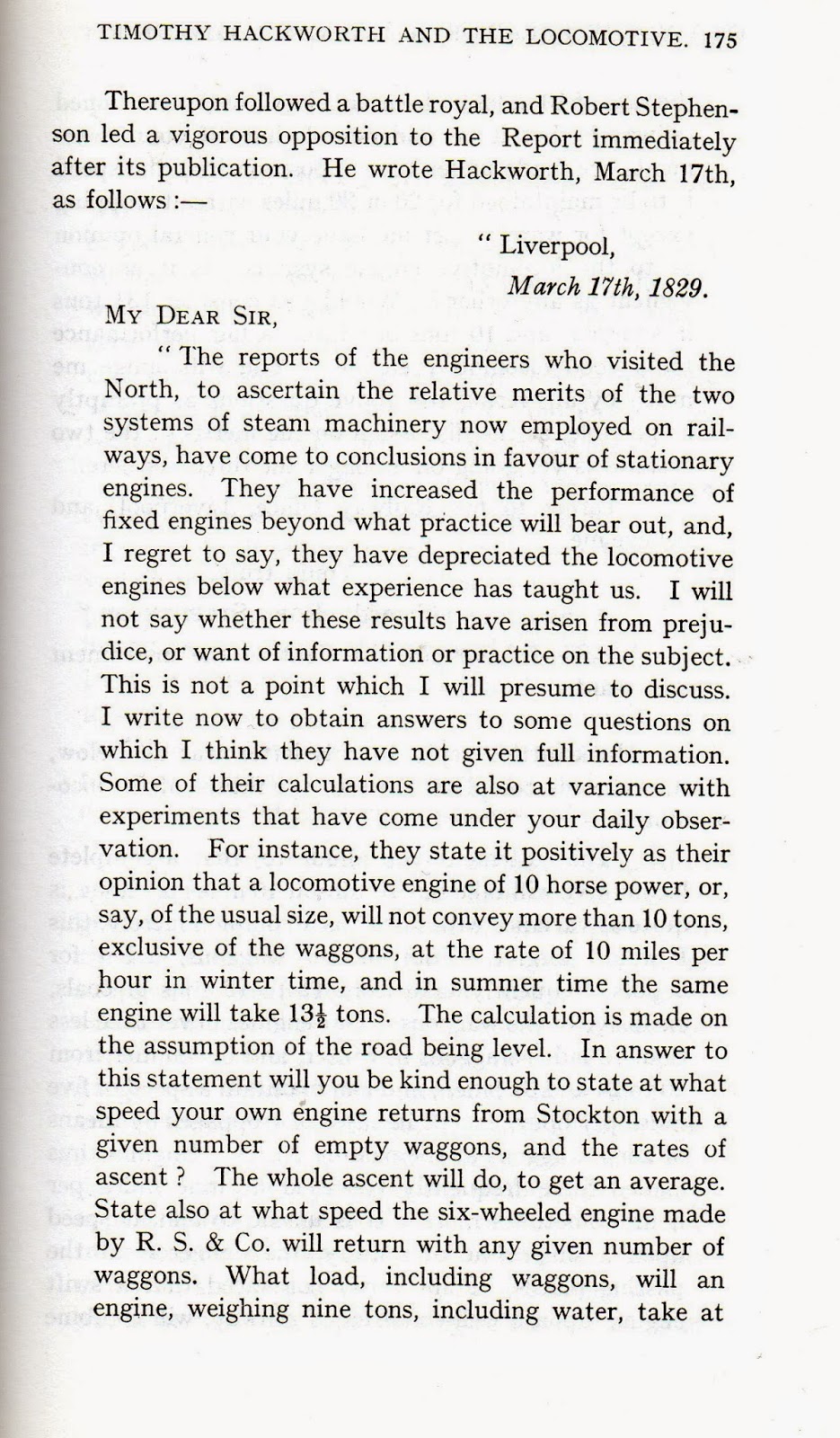A Letter to Timothy Hackworth
kept by his Thornaby descendants.
From the Northern Echo c1936
Timothy Hackworth "The Father of the Locomotives" to whom the people of Shildon put up a Mrs Winifred Parsons and her daughter Joan Hackworth Parsons (Weir) of 62, Mansfield Avenue, Thornaby, and Mrs Alderslade of 4, Northumberland Road. The two women are the granddaughters of John Wesley Hackworth who was the eldest son of Timothy Hackworth.
memorial
at the time of the Jubilee of Railways in 1925, has descendants at Thornaby. They are
Mrs Parsons, who is the wife of Harry Parsons, an engineer at Head Wrightsons and Co's works at Thornaby, has a number of Hackworth relics, including the original letter from Robert Stephenson to him dated 17th march 1829, in which he asked questions on technical matters regarding the two systems of steam machinery then employed on railways.
HORSE OR MACHINERY
When the first public railway, the Stockton and Darlington, was opened on the 27th september 1825, 20 miles of it were worked by locomotives and horses. The horses proved much more economical during the first 18 months and the directors, determined to suspend the locomotives. Before confirming this they asked Timothy Hackworth's opinion. He told them he could build them an engine capable of producing cheaper results than animal power. He was given authority to do so and it was then stated that this would be the 'last locomotive experiment'.
This locomotive, the Royal George, was built at New Shildon, by Timothy Hackworth and was completed in 1827. In the first year it hauled 22,442 tons of goods over the 20 miles of line at a cost of £466, whereas a corresponding amount of tonnage drawn by horses had cost £998.
HIS VISITING CARDS
" The Steam Blast (Blast Pipe), Timothy Hackworth's invention, was first used in this engine" Mrs Parsons told a Northern Echo reporter "It made possible the world's first railway system, and I and my daughter and my sister mrs Esther Alderslade and other descendants were present when the Timothy Hackworth memorial to Timothy Hackworth at Shildon was unveiled by the Rt. Hon T R Ferens on the 5th December 1925.
 |
| Miniature of Jane Hackworth nee Golightly from Joan Hackworth Weir Collection. Timothy's wife. |
The reporter was shown the etched plate from which Timothy Hackworth had produced his visiting cards There was a miniature of himself" added Mrs Parsons but another member of the family has it. There were, of course, no photographs in those days but i have copies of etchings of my great grandfather."
and a hand-painted miniature of his wife. "
Other railway relics she has are a bust of the first secretary of the Stockton and Darlington Railway and a number of medallions and a patent for inventions granted to John Wesley Hackworth showing that Timothy Hackworth's mechanical genius descended down to his son.
.................................
Most of the items mentioned and the 'blast pipe letter from George Stephenson have since be donated by Joan to NRM via her cousin Jane.
This is the letter referred to in above press cutting as it appears in Robert Young's book Timothy Hackworth and the Locomotive, first published in 1923. Like the 'blast Pipe letter from George Stephenson, this letter will have passed from Timothy Hackworth to his son John Wesley Hackworth who was originally going to write the book on his father, down to John's son Albert Hackworth who emigrated to the States, and back to the UK to be used by Robert Young in the early 1920's for his book and back to Albert's offspring, so that by 1936, the letter is clearly in the custody of Winifred Hackworth, Joan Hackworth Weir's mother and from Joan via Jane Hackworth-Young to NRM Hackworth Collection at York.
This is the letter referred to in above press cutting as it appears in Robert Young's book Timothy Hackworth and the Locomotive, first published in 1923. Like the 'blast Pipe letter from George Stephenson, this letter will have passed from Timothy Hackworth to his son John Wesley Hackworth who was originally going to write the book on his father, down to John's son Albert Hackworth who emigrated to the States, and back to the UK to be used by Robert Young in the early 1920's for his book and back to Albert's offspring, so that by 1936, the letter is clearly in the custody of Winifred Hackworth, Joan Hackworth Weir's mother and from Joan via Jane Hackworth-Young to NRM Hackworth Collection at York.
Letter from Robert Stephenson to Timothy Hackworth Liverpool March 17th 1829
This letter (and other's contained in Robert Young's book) "convey some idea of the unique position held by Timothy Hackworth. We find his experience solicited and his help required both by the deputation from the Liverpool and Manchester Railway Directors and by Robert Stephenson, not as a mere producer of costs and accounts, but as the one authority to whom they could confidently turn for advice and instruction." Robert Young.
Part 2 - the rest of the letter and the start of Hackworth's reply.
The full account around this a earlier letters can be found in Chapter X The Royal George 1822 to 1829 in Robert Young's book Timothy Hackworth and the Locomotive 1923 - 2000 edition available from Friends of National Railway Museum, York.
Robert Young - Author of Timothy Hackworth and the Locomotive
Photo via Ulick Loring (a descendant of Timothy Hackworth).
Timothy Hackworth memorial, Shildon










No comments:
Post a Comment